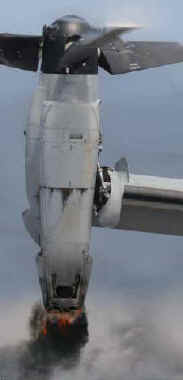 As the
V-22 program seeks another five-year contract to produce 98 more V-22s, the
sales pitch is spinning faster than ever. The V-22 has a poor safety record,
yet Marine spokesmen repeatedly claim that the "Navy Safety Center reports
...". This is because the Marines only report V-22 Class A mishaps
to Navy Safety Center if the mishap becomes public. In other cases,
airborne mishaps are reported as "ground" mishaps or false
damage estimates are made to remain below the Class A reporting requirement.
As the
V-22 program seeks another five-year contract to produce 98 more V-22s, the
sales pitch is spinning faster than ever. The V-22 has a poor safety record,
yet Marine spokesmen repeatedly claim that the "Navy Safety Center reports
...". This is because the Marines only report V-22 Class A mishaps
to Navy Safety Center if the mishap becomes public. In other cases,
airborne mishaps are reported as "ground" mishaps or false
damage estimates are made to remain below the Class A reporting requirement.
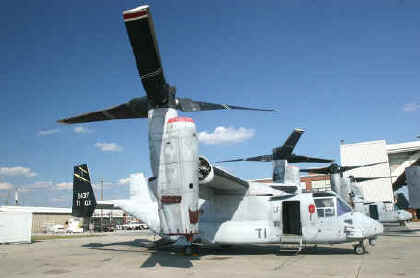 Some details of unreported
mishaps were published by "Inside
Defense" in 2006, by a
Navy
expert in 2009, and a follow
up appeared in "Wired" last year. Congress took an interest
in 2009, and after much stonewalling the Marine Corps admitted
that 29 of its 105 new V-22s were not flyable. Half of those can be traced to
retired test aircraft and crashes, but the Generals did not provide details on
why more than a dozen other new V-22s had become permanently unflyable.
Class A mishaps were never reported on V-22s that were damaged beyond repair,
since no damage estimate was ever made.
Some of these are stored in hangars and others designated as Ground Instruction Aircraft (GIA) to
excuse their permanent grounding, like the two pictured below.
Some details of unreported
mishaps were published by "Inside
Defense" in 2006, by a
Navy
expert in 2009, and a follow
up appeared in "Wired" last year. Congress took an interest
in 2009, and after much stonewalling the Marine Corps admitted
that 29 of its 105 new V-22s were not flyable. Half of those can be traced to
retired test aircraft and crashes, but the Generals did not provide details on
why more than a dozen other new V-22s had become permanently unflyable.
Class A mishaps were never reported on V-22s that were damaged beyond repair,
since no damage estimate was ever made.
Some of these are stored in hangars and others designated as Ground Instruction Aircraft (GIA) to
excuse their permanent grounding, like the two pictured below.
In 2006 an engine surge caused a V-22 leap 30 feet into the air with pilots at the controls. It rolled to one side and broke off a wing. The damage estimate was $16 million, but was much higher since the V-22 became a GIA. This was never reported to the Navy Safety Center as a serious accident. Here is a list of 50 Class A MV-22 mishaps. Note that eight of these mishaps were with FSD or EMD test aircraft. This list does not include the six Air Force CV-22 Class A mishaps.
Serious (Class A) Mishaps of Marine Corps V-22 Aircraft
| Serial Number | MV-22 Number | Mishap Date | Description of Class A Mishap |
| 163911 | 01 | 1999 | Not reported; damaged, stored at Hickory Museum |
| 163913 | 03 | Unknown | Not reported; moved to West Chester Helicopter Museum |
| 163914 | 04 | 20 Jul 1992 | Reported; crashed near Quantico VA; 4 killed |
| 163915 | 05 | 11 Jun 1991 | Reported; test aircraft crashed on runway; (photo) |
| 163916 | 06 | 1992 | Not reported; to China Lake for GIA |
| 164939 | 07 | Unknown | Not reported; scrapped in 2008 |
| 164941 | 09 | Unknown | Not reported; scrapped in 2008 |
| 164942 | 10 | 12 Feb 2003 | Not reported; overstressed (photo); scrapped 2006 |
| 165433 | 11 | 08 Apr 2000 | Not reported; hard landing at Marana; scrapped 04 Apr 06 |
| 165434 | 12 | Unknown | Not reported; scrapped 02 Oct 2007 |
| 165436 | 14 | 08 Apr 2000 | Reported; crashed after roll over at Marana, AZ; 19 killed |
| 165437 | 15 | 08 Sep 2005 | Not reported; GIA at New River, NC; photo |
| 165438 | 16 | Unknown | Not reported; GIA at New River, NC; photo |
| 165439 | 17 | Unknown | Not reported; scrapped 13 Sep 2004 |
| 165440 | 18 | 11 Dec 2000 | Reported; crashed near New River, NC; 4 killed |
| 165441 | 19 | Unknown | Not reported; GIA at Pensacola FL |
| 165442 | 20 | 17 May 2010 | Not reported; stored at NAVAIRSYSCOM |
| 165444 | 22 | 28 Jun 2004 | Misreported as Class B; scrapped 2 Feb 2012 |
| 165837 | 23 | Unknown | Not reported: retired to Quantico museum |
| 165839 | 25 | 31 Oct 2013 | Not reported; retired to USAF museum |
| 165844 | 30 | 11 Apr 2012 | Reported; crashed in Morocco; two killed |
| 165948 | 49 | 6 Nov 2007 | Reported; in flight engine fire; stored at New River, NC |
| 166385 | 52 | 28 Mar 2005 | Misreported as Class B; hydraulic/engine fire; stored at New River, NC photo; crewman permanently disabled |
| 166388 | 55 | 21Aug 2007 | Misreported as Class B; nose wheel collapse during emergency landing at Yuma, AZ |
| 166389 | 56 | 27 Mar 2006 | Misreported as a ground mishap; scrapped 14Jul09. |
| 166390 | 57 | 7 Dec 2006 | Misreported as Class B; fire damage |
| 166390 | 57 | 19 May 2014 | Reported; Crew Chief fell out while in flight |
| 166480 | 59 | 10 Jul 2006 | Misreported as Class B; engine destroyed by compressor stalls; emergency landing in Iceland |
| 166482 | 61 | 01 May 2006 | Not reported; engine fire at New River; scrapped 21 April 2010 |
| 166488 | 67 | 2008 | Damaged; stripped of parts at New River; photo |
| 166489 | 68 | 2009 | Damaged; repaired after eight years by LogMet |
| 166735 | 100 | 21 Jun 2013 | Reported; destroyed by fire after emergency landing |
| VMM-263 | Unknown | 21 Jun 2008 | Misreported as Class B; engine disintegrated during flight; emergency landing in Jordan. |
| 168005 | 135 | April 2001 | Not Reported; Landing gear collapse required depot repair |
| 167902 | 113 | 11 Jul 2011 | Reported; crewman killed by cargo while in flight, Afghanistan |
| Unknown | Unknown | 27 May 2009 | Not reported; swamp take-off crash causes fire damage |
| 167910 | 121 | May 2009 | Misreported as Class B; Engine seizure and fire while in flight |
| Unknown | Unknown | 09 Jul 2012 | Cross-shaft failure required emergency landing at Wilmington NC |
| 168234 | 184 | 01 Oct 2014 | Power loss upon take off, crewman drowned at sea |
| VMM-365 | Unknown | 2013 | Not reported; crash landing in Afghanistan |
| 168241 | 191 | 26 Aug 2013 | Reported; destroyed after fire and hard landing |
| VMM-161 | Unknown | Sept 2014 | Not reported; serious damage required rebuild |
| 168014 | 144 | 27 June 2014 | Not Reported; in Japan, details withheld |
| 168020 | 150 | 17 May 2015 | Reported; crash in LZ, two dead, destroyed by fire |
| Unknown | Unknown | 26 Oct 2016 | Reported then removed; nose gear collapse at NAS Patuxent River |
| 168027 | 157 | 13 Dec 2016 | Reported; crash landed near Okinawa. |
| Unknown | Unknown | 29 Jan 2017 | Reported; crash landing in Yemen after engine failure. |
| Unknown | Unknown | 5 Aug 2017 | Reported; power lacking upon launch, lost at sea with 3 dead. |
| 168281 | Unknown | 29 Sep 2017 | Reported; crash landing in Syria, two injured, destroyed. |
| 168026 | 155 | 9 Dec 2015 | Reported; set down short of flight deck, fuselage cracked. |
Primary Sources: TargetLock; Helis; Joe Baugher Navy Bunos; Navy Safety Center
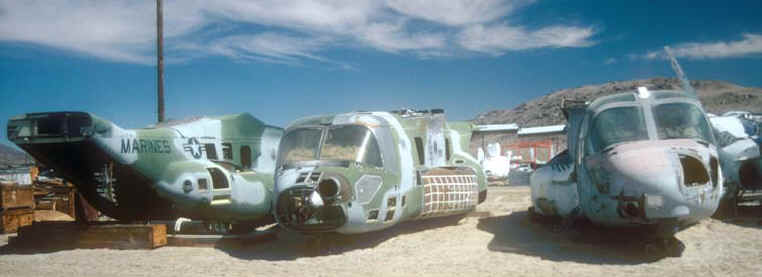
A common excuse for V-22 failures is that all new aircraft have problems. Yet the V-22 is not a new aircraft, it first flew in 1989 and the Marine Corps began receiving production aircraft in 1998. It is older than the C-17 program and plans for the final production run are in place. These new V-22s are often compared to 40-year old helicopters that should have been retired several years ago because of metal fatigue. If you owned a fleet of trucks, would you expect your newly purchased trucks to have fewer problems than your 40-year olds? Yet the V-22 has a lower readiness rate and a higher accident rate than old helicopters. This is why the Marines never deployed more than 10 V-22s to Afghanistan, favoring 40 year old CH-53D helicopters.
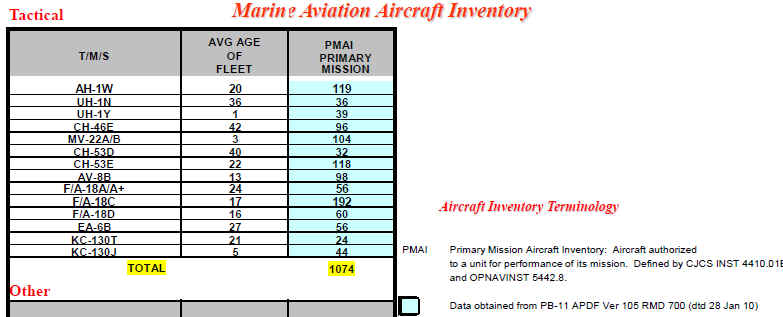
The recent deployment of 24 V-22s to Japan has stirred political tensions, resulting in a 228 page report (warning: large pdf file) about the impact these will have on Okinawa. They are to be based at MCAS Futenma, a small airbase located in the middle of an Okinawan city, replacing 24 CH-46E helicopters. The Okinawans have demanded Futenma's closure for decades. The Marines have been spinning a tale that V-22s are safer than helicopters and claim the V-22 has suffered only three Class A mishaps, while the list above notes 50 plus 6 by Air Force CV-22s.
Marine Generals may spin stories as to why many of those were not Class As, but they cannot explain why two dozen new $80 million V-22s have been scrapped or permanently grounded without incurring more than a million dollars in damage. In contrast, C-17s were produced at roughly the same time frame as the V-22, but only three C-17s are no longer in active service out of 223 produced, to include test aircraft.
According to V-22 consultant and retired aviation expert Rex Rivilio, the V-22 is safe, so long as it doesn't hover. The Marines could promise that V-22s wouldn't hover around its tiny Futenma airbase in the VTOL mode, performing only rolling take-offs and landings. However, operating a tiny military airbase in the middle of any city is unnecessary and therefore unsafe. New Yorkers wouldn't tolerate a foreign military airbase operating in Central Park (below), which is slightly smaller than Futenma.

Japanese leaders must provide independent analysis to American leaders so they are aware their Generals lie to them. The V-22 does not have an excellent safety record, and the Futenma airbase is not vital to anyone's national defense. To say 24 V-22s (small transports) are essential to regional stability is foolish, they aren't even weapons. A simple compromise would close MCAS Futenma and move 12 V-22s to the nearby Air Force Kadena airbase and 12 others to MCAS Iwakuni on mainland Japan.
Marine Corps Brig. Gen. James F. Amos once stated: "I think the V-22 probably is high maintenance at this point. I think -- but make sure you understand one thing. Any new airframe at this point or any new system is going to be high maintenance. And why would that be? Because first of all, there is the real lack of experience in maintaining this."
He made that statement in 2000, yet V-22 apologists still
claim that high costs and low readiness is only a problem because the V-22 is new. Back in 2001, everyone thought that
Brig. Gen. Amos would be forced to retire after he was caught telling lies about
V-22 readiness and conspiring to hide V-22 failures from civilian leaders. The
Inspector General even seized his computer. Pentagon insider Franklin
"Chuck" Spinney" summarized:

General Amos was not forced to retire, but was rewarded with three more promotions and is now the top Marine - the Commandant! He continues to spin lies about the V-22's readiness, safety record, performance, and the need to keep Futenma open. The lesson learned for ambitious Marine officers is that telling lies to hide problems is not only tolerated, but rewarded. It is time for American civilian leaders to overrule their Generals for the good of the Marine Corps, the American taxpayer, and the people of Japan.
Carlton Meyer editorG2mil@Gmail.com
©2015 www.G2mil.com (mishaps updated)
August
2014 Update 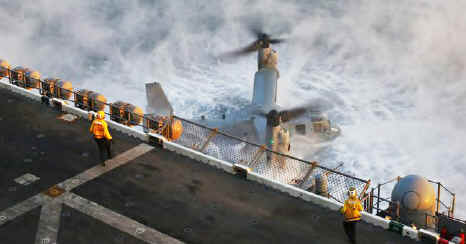
After reading about a June 27, 2014 V-22 mishap in Japan, I checked the Navy Safety Center website for details. Their link is dead, and I learned that one must now request such data with a FOIA request. Oct 1, 2014 mishap pictured at right.
January 2015 Update
 General Amos
retired as Commandant on Dec. 1, 2014. He promptly cashed in by joining
the board of directors of the Lord Corporation on Jan 6, 2015, a company that
has been paid billions of dollars for V-22 components and spare parts. Amos
waited just 36 days after retirement to rejoin the V-22 sales effort. Note that
Jan 6th was the announcement date, meaning the details of his "compensation"
were negotiated well before that date.
General Amos
retired as Commandant on Dec. 1, 2014. He promptly cashed in by joining
the board of directors of the Lord Corporation on Jan 6, 2015, a company that
has been paid billions of dollars for V-22 components and spare parts. Amos
waited just 36 days after retirement to rejoin the V-22 sales effort. Note that
Jan 6th was the announcement date, meaning the details of his "compensation"
were negotiated well before that date.
His predecessor, General James T. Conway, has joined the board of V-22 manufacturer Textron, and two other corporations that do business with the Marine Corps -- Colt and General Dynamics.
January 2016 - V-22 Mishaps in Afghanistan 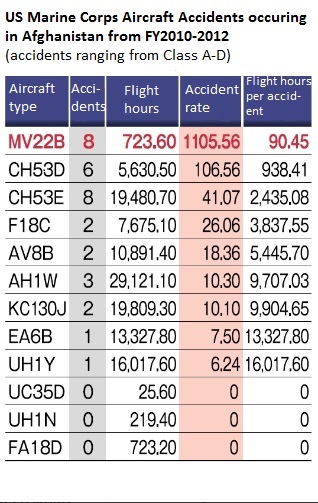
We continue to hear public relations spin about the great V-22 Osprey. In reality, it costs twice as much to procure and maintain as similar size helicopters, but can only lift one quarter as much. Its only advantage is that it can fly 40% faster. Its ready rate is half that of helicopters, with more than half of these new aircraft down for repairs at all times because it's a very complex machine constructed of lightweight composite parts. The Marine Corps keeps this data hidden, but a Japanese news team used FOIA requests to pry this chart out of the Navy Safety Center. This chart also shows how little the V-22 was used in Afghanistan, where the same number of 42-year old CH-53Ds flew much more.
The real mishap rate is probably much worse, given that senior Marine officers have been caught manipulating mishap and readiness data several times. For example, another article noted: "The U.S. authorities calculate the accident frequency rate based on the number of Class A mishaps, and the rate for the CV-22 is 13.47, and 1.93 for the MV-22." Are Marine Corps aircrews really six times safer than Air Force crews flying the same aircraft?